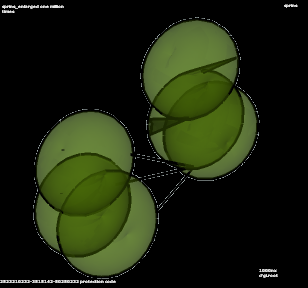Sprins
From Sprinsology
Sprins is a unique mixture of molecules determining the spray's properties. It assembles systematically. Sprins' parts are units – elements (small mixtures of molecules) and binders – nervulae.
Contents |
Elements and nervulae
There are three types of elements:
- main (majors)
- rare (minors)
- very rare (malaya, singular malay)
Main elements are:
- Parsintha (marked with P)
- Hyania (marked with H)
- Oropia (marked with O)
- Corothola (marked with C)
- Sallicina (marked with S)
Rare elements are:
- Vidiridia (marked with V)
- Elocca (marked with E)
- Ipicca (marked with I)
- Tattana (marked with T)
There is only one discovered and documented malay: Quegnaroc (marked with Q).
There are three types of nervulae:
- single
- double
- triple
Unitae assembly and naming
Unitae types
Unitae are a group of elements (similar to molecules in chemistry). They are inseparable, unlike chemical compounds. An example is P3H. There are many types of unitae:
- Unitae
- Unithyns
- Unithyls
- Unithyms
- Unitiae
- Unithals
- Visuals
- Olfaudi
- Malayalae
Unitae can be also elementary, such as P, P2, P3, H4 etc.
Superstem and substem of elements
The superstem and substem are unique "words" that are very important in unitae naming. Every element has an unique superstem and a substem. They are:
- Parsintha: pars-, -an
- Hyania: hyn-, -im
- Oropia: orop-, -on
- Corothola: kor-, -ol
- Sallicina: sal-, -il
- Vidiridia: vid-, -at
- Elocca: el-, -et
- Ipicca: ip-, -it
- Tattana: tatt-, -ut
- Quegnaroc: quegnar-, -oc
Note: superstem is on the left and substem is on the right.
Number prefixes
The number prefixes come from Latin or pseudo-Latin. They are also very important during the naming process, since they use to determine how many single elements are in the unitae. Every number has two types, because a prefix can stand before a vowel and also before a consonant. They are:
- 1: no prefix
- 2: di- or d-
- 3: tri- or tr-
- 4: que- or qu-
- 5: qui- or quin-
- 6: se- or sex-
- 7: sa- or sept-
- 8: octa- or oct-
- 9: nova- or nov-
- 10: deci- or dec-
- 11: ununi- or unun-
- 12: undi- or und- etc.
Unithyns
Unithyns are elementary compounds (unitae) with two or three articles (each element in the compound). Remember, the third article is optional. The articles can be mixed, that is, major or minor (not malaya). That could be Sallicina, Parsintha, Tattana or others. The basic or the general formula (the formula that determines the number of certain articles in the compound) is:
AxBx+2Cx+1
According to the formula, if element A is Parsintha, and element B is Hyania, then the formula would be PH3. If there are three articles: Parsintha, Hyania and Ipicca, then the formula would be PH3I2. The elements A and B or A and C cannot be the same, but elements B and C can be. The general formula changes:
AxB2x+3
Those unithyns are called irregular unithyns. For example: PH3H2 becomes PH5. Every unita can be connected to the other one when building a sprins. Every type of unita has a certain nervulae-connecting number. The unithyns can be connected to two, three or four nervulae - they are two-, three- or four-nervulistic. Unitae are also named: every type of unita has a system of naming. Unithyns have a system like so:
(A number prefix)(A superstem)i(B number prefix)(B substem)in-(C number prefix)(C superstem)in
An example: PH3 would be called Parsitrihynin.


